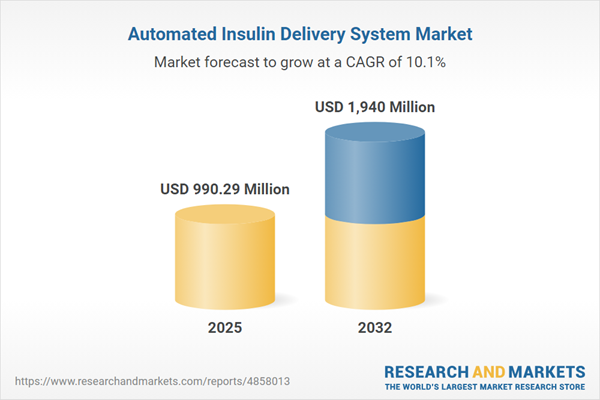Speak directly to the analyst to clarify any post sales queries you may have.
Automated insulin delivery systems are transforming diabetes management for healthcare organizations, offering connected, data-driven platforms capable of streamlining patient care and supporting strategic operational goals. As this technology becomes integral to digital health initiatives, senior decision-makers are positioned to lead modernization strategies that drive process improvements and greater care coordination.
Market Snapshot: Automated Insulin Delivery System Market
The automated insulin delivery system market continues to expand quickly, with strong demand from healthcare providers seeking advanced solutions that simplify glycemic monitoring and optimize insulin administration. The current market value stands at USD 901.04 million in 2024 and is projected to grow to USD 990.29 million by 2025. Forecasts show the sector could reach approximately USD 1.94 billion by 2032, propelled by a robust compound annual growth rate of 10.07%. This upward trend reflects a surge in demand for digital platforms supplying accurate, real-time glucose data and reliable interoperability with electronic medical records and telehealth infrastructure. Leadership teams now view seamless platform integration and interoperability as critical requisites to enhance responsiveness to both organizational and external regulatory shifts.
Scope & Segmentation of the Automated Insulin Delivery System Market
This report provides deep insight into the evolving structure and trends of the automated insulin delivery system market. Focused analysis of technology adoption and segmentation helps inform investment priorities for healthcare leaders, supporting both risk mitigation and long-term value realization.
- Product Type: Fully closed loop systems, hybrid models, sensor-augmented pumps, and threshold suspend systems are engineered to ensure flexibility in diverse care environments, including high-acuity hospital settings and outpatient care.
- Component: Real-time and flash glucose monitoring platforms, cloud-based algorithms, mobile systems, and both patch and tubed pumps address a wide spectrum of patient needs and care protocols.
- Insulin Type: The adoption of rapid-acting insulin subtypes such as aspart, glulisine, lispro, as well as U100 and ultra-rapid formulations, allows clinicians to tailor dosing strategies to patient-specific requirements.
- Technology: Integration of Bluetooth, cellular, and WiFi improves device compatibility with healthcare IT, increasing workflow efficiency for telehealth and EMR systems.
- Diabetes Type: Solutions are developed for all main diabetes categories—type 1, type 2, and gestational—and consider both adult and pediatric populations.
- Care Setting: System adaptability encompasses utilization in inpatient wards, intensive care, outpatient clinics, and specialty centers, ensuring solutions fit distinct institutional contexts.
- End User: Hospitals, clinics, ambulatory providers, and home care teams benefit from the market’s comprehensive product coverage, providing care continuity for a diverse patient base.
- Distribution Channel: Availability through online and offline pharmacy networks aligns with efforts to broaden accessibility and coordinate with digital health strategies.
- Region: The market spans the Americas, Europe, Middle East, Africa, and Asia-Pacific, considering regulatory frameworks, reimbursement pathways, and unique procurement models specific to each region.
- Company Profiles: Detailed evaluation of leading suppliers including Medtronic plc, Tandem Diabetes Care, and Insulet Corporation, underlines varied technology approaches and go-to-market strategies supporting organizational decision-making.
Key Takeaways for Senior Decision-Makers
- Automated insulin delivery systems promote precision care and enable alignment with evolving clinical guidelines and changing healthcare policies.
- Technology integration across all care environments supports the harmonization of new digital tools with legacy systems, increasing institutional agility and responsiveness.
- Embracing modular system architectures allows organizations to efficiently navigate regulatory updates while optimizing upgrade cycles and configuration management.
- Supplier diversification and strategic sourcing can safeguard operations from supply chain volatility and emerging regulatory demands.
- Consistent evaluation of regulatory conditions and innovations positions organizations to harness emerging technologies, supporting quality improvement initiatives in patient care.
Tariff Impact
As tariff modifications are anticipated for 2025, procurement and supply chain leaders are encouraged to explore diversified sourcing and trusted cross-border partnerships. Incorporating proprietary digital health systems can provide resilience and help maintain target financial performance during market fluctuations prompted by revised trade agreements or tariffs.
Methodology & Data Sources
The findings in this report are based on peer-reviewed research, analysis of regulatory databases, and structured interviews with executives in healthcare operations and supply chain management. Scenario-based market evaluations contribute actionable recommendations designed for leadership teams pursuing risk-adjusted growth and strategic market entry planning.
Why This Report Matters
- Assists senior leadership in refining segmentation and positioning strategies within the automated insulin delivery systems market for differentiated opportunities.
- Supports procurement optimization and effective risk mitigation during technology transitions and regulatory updates.
- Guides successful adoption of advanced insulin management technologies within broader institutional digital transformation programs.
Conclusion
Automated insulin delivery systems are driving healthcare organizations toward smarter care and streamlined processes. This report offers leaders actionable insights to identify opportunity and support ongoing operational improvements in a rapidly evolving market.
Additional Product Information:
- Purchase of this report includes 1 year online access with quarterly updates.
- This report can be updated on request. Please contact our Customer Experience team using the Ask a Question widget on our website.
Table of Contents
3. Executive Summary
4. Market Overview
7. Cumulative Impact of Artificial Intelligence 2025
Companies Mentioned
The companies profiled in this Automated Insulin Delivery System market report include:- Medtronic plc
- Tandem Diabetes Care, Inc.
- Insulet Corporation
- F. Hoffmann-La Roche Ltd
- Beta Bionics, Inc.
- Bigfoot Biomedical, Inc.
- Ypsomed AG
- Diabeloop SAS
- Sooil Development Co., Ltd.
- DreaMed Diabetes Ltd.
Table Information
| Report Attribute | Details |
|---|---|
| No. of Pages | 196 |
| Published | October 2025 |
| Forecast Period | 2025 - 2032 |
| Estimated Market Value ( USD | $ 990.29 Million |
| Forecasted Market Value ( USD | $ 1940 Million |
| Compound Annual Growth Rate | 10.0% |
| Regions Covered | Global |
| No. of Companies Mentioned | 11 |









